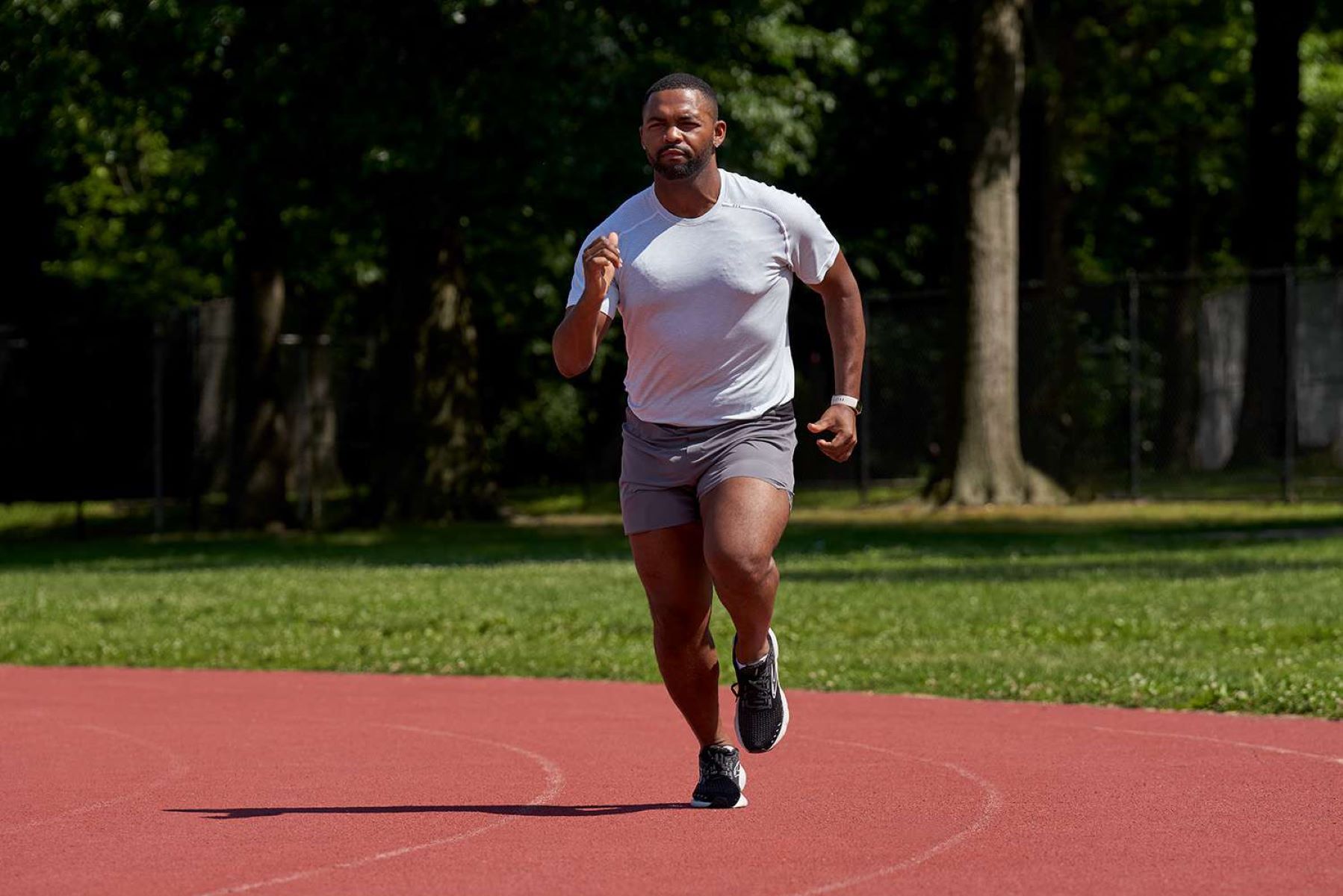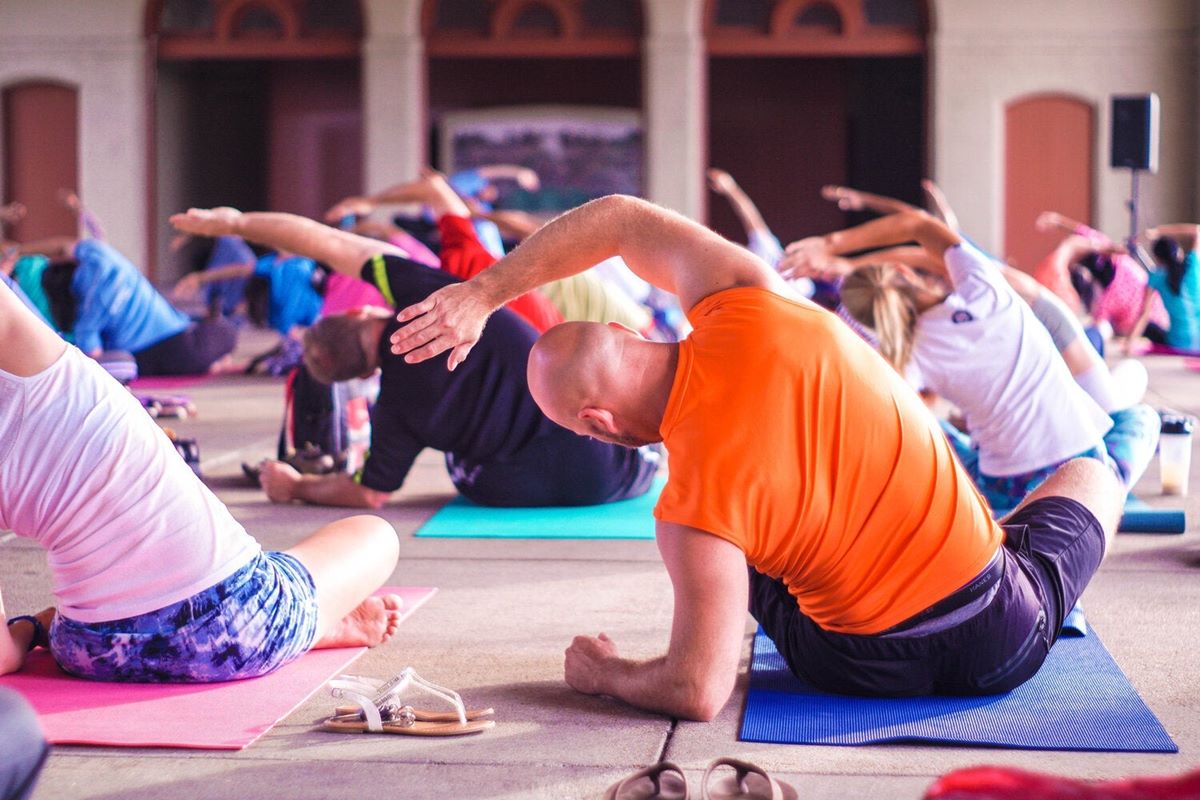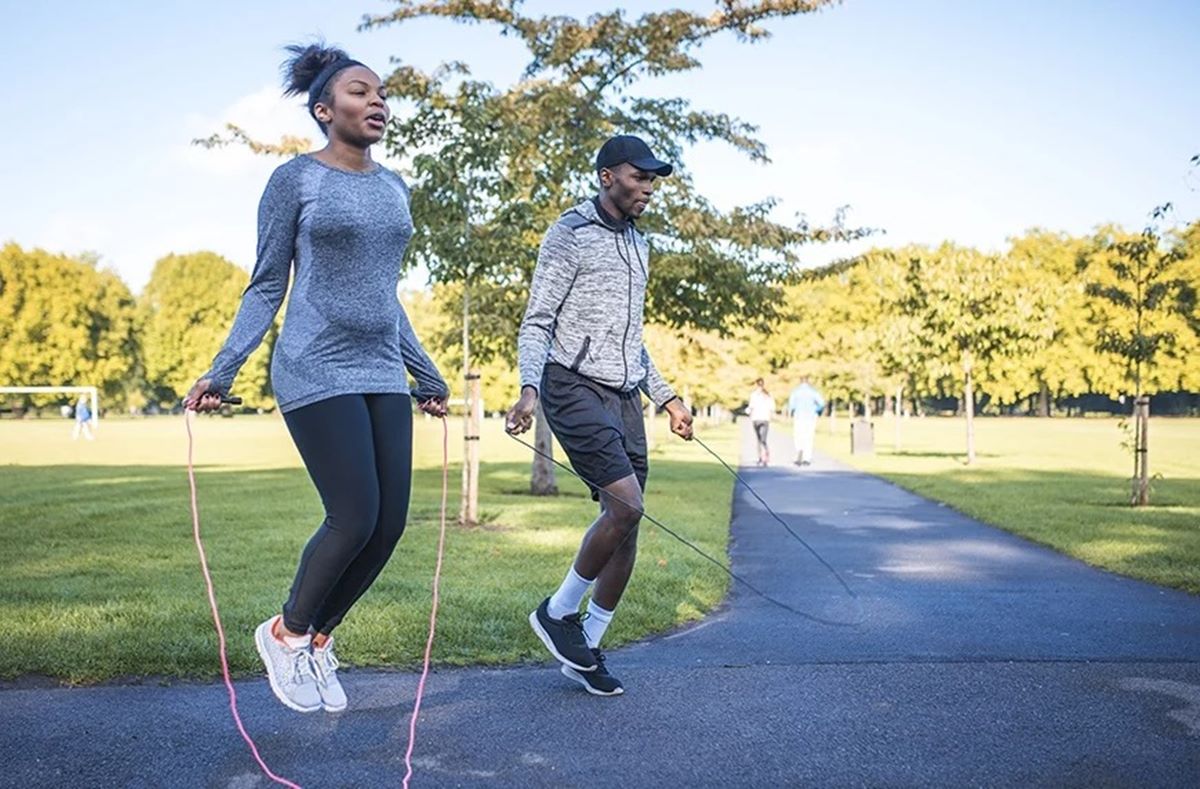

Featured
How To Get A Higher Stamina
Modified: January 22, 2024
Learn how to increase stamina and improve your endurance with our featured guide. Boost your energy levels and achieve peak performance.
Introduction
Welcome to the world of fitness and endurance! If you’ve ever felt exhausted after climbing a flight of stairs or struggled to keep up with your favorite physical activities, then you might be in need of a stamina boost. Stamina, or endurance, is the ability to sustain physical exertion over an extended period of time. It plays a vital role in achieving optimal performance in various activities, from sports to everyday tasks.
Whether you’re an athlete striving to improve your performance or simply someone looking to enhance your overall fitness level, increasing stamina should be a key objective. This article will guide you on how to boost your stamina, allowing you to unlock new levels of physical endurance.
As with any fitness goal, it’s important to approach stamina building with a holistic perspective. This means focusing on several aspects of your life, including nutrition, hydration, exercise, rest, and mental strategies. By addressing each of these areas, you can optimize your body’s ability to perform for longer periods of time.
Throughout this article, we will delve into the different components that contribute to stamina and explore various techniques and tips to help you increase your endurance levels. But first, let’s take a closer look at what stamina really is and why it is important.
Understanding Stamina
Stamina is the ability of your body to sustain prolonged physical activity or exertion without getting tired or exhausted. It is a combination of both muscular and cardiovascular endurance. Muscular endurance refers to the ability of your muscles to perform repetitive movements over a period of time, while cardiovascular endurance relates to the efficiency of your heart, lungs, and blood vessels in delivering oxygen to your muscles during exercise.
Stamina can vary from person to person and is influenced by factors such as genetics, lifestyle, and training. Some individuals naturally possess higher levels of stamina, while others may need to work on improving it through deliberate effort. Regardless of your starting point, it’s important to remember that stamina is not a fixed attribute and can be developed and enhanced.
There are two types of stamina: aerobic and anaerobic. Aerobic stamina, also known as cardiovascular stamina, is the ability to sustain low to moderate intensity exercises over a longer duration. This includes activities like jogging, biking, and swimming. Anaerobic stamina, on the other hand, refers to the ability to sustain high-intensity exercises for shorter bursts, such as weightlifting or sprinting.
Understanding the different types of stamina is important because it will guide you in tailoring your training program to target the specific energy systems utilized in different activities. By focusing on both aerobic and anaerobic stamina, you can improve your overall endurance and performance in a wide range of physical activities.
Improving stamina requires a systematic approach that combines various factors, including nutrition, hydration, exercise, rest, breathing techniques, and mental strategies. By addressing all these aspects, you can effectively optimize your body’s energy production and utilization systems, enabling you to go further and faster with reduced fatigue.
Now that we have a better understanding of what stamina entails, let’s explore the importance of building and maintaining a high level of endurance.
Importance of Stamina
Stamina is not just important for athletes and fitness enthusiasts; it is a crucial aspect of overall health and well-being. Here are some reasons why stamina is important:
- Enhanced Performance: Whether you’re participating in a competitive sport or engaging in everyday activities, having good stamina allows you to perform at your best. With increased stamina, you can sustain physical exertion for longer periods without experiencing excessive fatigue. This can give you a competitive edge and improve your ability to meet the demands of your daily life.
- Efficiency and Productivity: When you have high stamina levels, your body can efficiently utilize energy and oxygen, which leads to improved productivity in various tasks. Whether it be at work, studying, or completing household chores, having stamina helps you stay focused and energetic for extended periods, increasing your efficiency and reducing the likelihood of burnout.
- Weight Management: Regular physical activity, which requires stamina, is essential for maintaining a healthy weight. When you engage in exercises that challenge your stamina, your body burns calories and fat, promoting weight loss and better weight management. Additionally, stamina-building exercises can help boost your metabolism, enabling you to burn more calories even at rest.
- Enhanced Cardiovascular Health: Stamina-building activities, such as cardio exercises, work the heart and blood vessels, strengthening them over time. This improves your cardiovascular health by reducing the risk of various conditions, including heart disease, high blood pressure, and stroke. Additionally, increased stamina promotes efficient oxygen delivery to the body, reducing the workload on the heart.
- Reduced Fatigue and Stress: Developing stamina helps your body become more resilient to physical and mental stressors. When you have good stamina, you are less likely to feel exhausted and fatigued after performing tasks or engaging in physical activities. This can have a positive impact on your overall mood and mental well-being, reducing stress and promoting a sense of accomplishment.
It’s clear that stamina plays a vital role in enabling us to perform at our best, both physically and mentally. By focusing on developing and maintaining our endurance levels, we can enjoy numerous benefits that contribute to our overall health, well-being, and quality of life.
Nutrition for Increasing Stamina
The food you consume plays a crucial role in fueling your body and providing the necessary nutrients for improved stamina. Here are some key nutrition tips to enhance your endurance:
- Balance Macronutrients: Ensure that your meals consist of a balance of carbohydrates, proteins, and healthy fats. Carbohydrates are the body’s primary source of energy, so include whole grains, fruits, and vegetables in your diet. Proteins are essential for muscle repair and growth, so consume lean meats, fish, eggs, and plant-based sources like beans and legumes. Healthy fats, found in avocados, nuts, and olive oil, provide sustained energy and support overall health.
- Maintain Hydration: Proper hydration is essential for optimal stamina. Dehydration can lead to decreased energy levels and performance. Drink sufficient water throughout the day, especially before, during, and after physical activity. If engaging in prolonged or intense exercises, consider sports drinks to replenish electrolytes lost through sweat.
- Pre-Exercise Fueling: Before a workout or physical activity, consume a balanced meal or snack that includes carbohydrates and a moderate amount of protein. This will provide your body with the necessary energy to sustain physical exertion. Opt for foods like whole grain toast with peanut butter, yogurt with fruits, or a small chicken and vegetable sandwich.
- During-Exercise Fueling: For longer duration activities, consider incorporating energy-boosting snacks or drinks. Options like energy gels, sports drinks, or a banana can provide a quick source of energy and help sustain stamina during prolonged workouts or endurance events.
- Post-Exercise Recovery: After intense workouts, focus on replenishing the body’s glycogen stores and aiding muscle recovery. Include protein-rich foods like lean meats, Greek yogurt, or a protein shake in your post-workout meal. Additionally, consuming carbohydrates and electrolytes helps restore energy levels and rehydrate the body.
- Optimize Micronutrients: Ensure you obtain a variety of vitamins and minerals through a well-balanced diet. These micronutrients support overall health and energy production in the body. Include foods like fruits, vegetables, nuts, seeds, and whole grains to ensure you’re getting a wide range of essential nutrients.
By fueling your body with the right combination of macronutrients and staying hydrated, you can optimize your energy levels and sustain your stamina during physical activities. Remember, it’s important to listen to your body and adjust your nutrition based on your specific needs and activity levels.
Hydration for Stamina Enhancement
Proper hydration is essential for optimal stamina and overall physical performance. When you’re dehydrated, both your physical and mental abilities are affected, leading to decreased endurance and increased fatigue. Here are some key points to keep in mind for effective hydration:
- Monitor Your Fluid Intake: Pay attention to your fluid intake throughout the day, not just during exercise. Aim to drink at least 8 cups (64 ounces) of water daily, and adjust your intake based on factors such as activity level, climate, and individual needs. Remember that thirst is not always an accurate indicator of hydration, so make a conscious effort to consume fluids regularly.
- Pre-Exercise Hydration: Start your physical activities well-hydrated by drinking water before you begin. This helps ensure you have adequate fluid reserves in your body to sustain your endurance. Aim to consume about 16-20 ounces of water 1-2 hours before your workout or event.
- During-Exercise Hydration: For longer duration exercises or intense physical activities, it’s important to replenish fluids during the activity. Take regular sips of water or a sports drink to maintain hydration levels and prevent dehydration. Sports drinks can be particularly helpful for replenishing electrolytes lost through sweat during prolonged exercise sessions.
- Post-Exercise Rehydration: After completing your workout or physical activity, make sure to rehydrate as part of your recovery routine. This is crucial for restoring your fluid balance and aiding in the recovery process. Consume water or a sports drink to replace the fluids lost during exercise.
- Monitor Urine Color: A simple way to gauge your hydration level is to observe the color of your urine. If it’s pale yellow or clear, it indicates that you’re well-hydrated. However, if it’s dark yellow or amber, it suggests dehydration, and you should increase your fluid intake.
- Consider Electrolyte Balance: Electrolytes, such as sodium, potassium, and magnesium, play a crucial role in hydration and muscle function. If you’re engaging in prolonged or intense exercise, consider consuming foods or beverages that contain electrolytes or using electrolyte-fortified drinks.
- Personalize Hydration Strategies: Everyone’s hydration needs may vary based on individual factors like body weight, sweat rate, and exercise intensity. Pay attention to your specific hydration requirements and adjust your fluid intake accordingly. It may be helpful to consult with a sports nutritionist or healthcare professional to determine a hydration plan personalized to your needs.
Remember, staying hydrated is not just about drinking water during exercise. It’s a continuous process that requires consistent fluid intake throughout the day to optimize your stamina and overall performance.
Effective Cardiovascular Exercises for Building Stamina
Cardiovascular exercises are key for building stamina and enhancing your endurance levels. These exercises elevate your heart rate, improve your lung capacity, and contribute to the efficient transportation of oxygen and nutrients to your muscles. Here are some effective cardiovascular exercises to boost your stamina:
- Running/Jogging: Running or jogging is a classic cardiovascular exercise that helps improve stamina. Start with a comfortable pace and gradually increase your speed and distance over time. Incorporate interval training, where you alternate between periods of high-intensity running and recovery periods of low-intensity jogging or walking, to challenge your cardiovascular system.
- Cycling: Cycling is a low-impact activity that can be done outdoors or on a stationary bike. It works the large muscles in your legs and helps build stamina. Adjust the resistance level or choose hilly terrains to challenge yourself and improve your cardiovascular endurance.
- Swimming: Swimming is a full-body workout that provides a low-impact yet highly effective cardiovascular exercise. It targets multiple muscle groups while placing minimal stress on the joints. Incorporate different swim strokes and interval training to maximize the benefits and increase your stamina in the water.
- Skipping Rope: Jumping rope is a great cardiovascular exercise that can be done anywhere with just a simple piece of equipment. It improves coordination, agility, and stamina. Start with shorter intervals and gradually increase the duration or incorporate different jump patterns to keep challenging yourself.
- High-Intensity Interval Training (HIIT): HIIT involves short bursts of intense exercise followed by brief recovery periods. This dynamic and challenging workout not only improves cardiovascular endurance but also helps burn calories effectively. Choose exercises like burpees, squat jumps, mountain climbers, or high knees, and tailor the intervals and intensity to your fitness level.
- Aerobic Dance Classes: Participating in aerobic dance classes, such as Zumba or aerobics, is a fun way to improve stamina. These classes combine energetic movements with music, providing an enjoyable and effective cardiovascular workout. The variety of choreography keeps you engaged and challenges your stamina in different ways.
- Rowing: Rowing is an excellent full-body workout that engages multiple muscle groups while providing a cardiovascular challenge. Whether you use a rowing machine at the gym or row on open water, it helps build endurance and strength. Focus on maintaining a steady pace and gradually increase the intensity and duration of your rowing sessions.
Remember to start gradually and listen to your body, gradually increasing the intensity and duration of your cardiovascular exercises. Consistency is key—aim for at least 150 minutes of moderate-intensity cardio exercise or 75 minutes of vigorous-intensity exercise per week to see improvement in your stamina over time.
Strength Training for Endurance
Strength training is often associated with building muscle mass and strength, but it is also an effective method for improving endurance and stamina. Incorporating strength training exercises into your fitness routine can provide numerous benefits, including increased muscular endurance and improved overall stamina. Here’s how strength training can help enhance your stamina:
- Increased Muscle Endurance: Engaging in strength training exercises with higher repetitions and lower weights helps build muscle endurance. This means your muscles can work for longer periods before experiencing fatigue. As your muscles become more resistant to fatigue, you can perform physical tasks with greater ease and sustain your stamina during activities.
- Improved Efficiency: Strength training improves the efficiency of your movement patterns and allows your muscles to work more effectively. This can translate into increased stamina by optimizing your energy expenditure during various activities. As your muscles become stronger and more efficient, they require less energy to perform tasks, thereby reducing fatigue and supporting greater endurance.
- Enhanced Muscle Power: Strength training exercises that focus on explosive movements, such as plyometrics and powerlifting, help develop fast-twitch muscle fibers, which are responsible for generating high-intensity bursts of power. By improving your muscle power, you’ll have the ability to sustain higher levels of exertion and perform explosive movements with less fatigue.
- Improved Joint Stability: Strength training helps strengthen the muscles around your joints, improving their stability and reducing the risk of injury. By building stronger and more stable joints, you can engage in physical activities for longer durations without experiencing discomfort or joint-related fatigue.
- Supportive Posture and Form: Proper form and posture are essential for maintaining stamina during physical activities. Strength training exercises, such as squats, deadlifts, and rows, enhance your core stability and promote better posture. This allows you to maintain proper alignment, distribute load efficiently, and minimize energy wastage, ultimately improving your stamina.
- Cross-training Benefits: Incorporating strength training alongside cardiovascular exercises can provide a well-rounded approach to improving stamina. By engaging in both types of training, you enhance different aspects of your fitness, including cardiovascular endurance, muscular strength, and endurance. This comprehensive approach helps you build a solid foundation of stamina for various activities.
- Progressive Overload: To continually challenge your stamina and see improvements, it’s important to progressively overload your muscles during strength training. Gradually increase the weights, repetitions, or difficulty level of your exercises over time. This progressive approach ensures that your muscles are consistently pushed beyond their comfort zone, leading to increased endurance and improved stamina.
Integrate strength training exercises into your fitness routine at least two to three times per week. Focus on compound exercises that target multiple muscle groups and incorporate both upper and lower body movements. Don’t forget to warm up properly before each session and listen to your body to prevent overtraining or injury. With consistent strength training, you’ll notice improvements in your muscular endurance and overall stamina.
Rest and Recovery for Stamina Enhancement
Rest and recovery are often overlooked aspects of fitness, but they play a vital role in enhancing stamina and overall performance. Without adequate rest, your body and mind can become exhausted, leading to poor stamina and decreased endurance. Here’s why rest and recovery are crucial for stamina enhancement:
- Muscle Repair and Growth: When you engage in physical activities, your muscles undergo stress and micro-tears. Rest and recovery allow these muscles to recover and repair, leading to stronger and more resilient muscle fibers. This repair and growth process is essential for improving muscular endurance and stamina.
- Replenishing Energy Stores: During intense exercise, your body depletes its energy stores, such as glycogen. Resting and providing your body with proper nutrition allows these stores to be replenished. Having sufficient energy stores contributes to improved stamina, as your body will have the necessary fuel to sustain physical activity for longer durations.
- Reducing the Risk of Overuse Injuries: Continuous, high-intensity training without adequate rest can lead to overuse injuries, such as stress fractures, tendonitis, and muscle strains. These injuries not only hinder your progress but can also sideline you from physical activities. Rest and recovery periods give your body time to heal and prevent the risk of these injuries, enabling you to maintain consistent training and improve your stamina over the long term.
- Mental Rejuvenation: Rest days are just as important for your mental well-being as they are for your physical recovery. Training and maintaining high stamina require mental focus and discipline. Giving yourself time to relax and recharge not only helps prevent mental burnout but also enhances your overall motivation and mental resilience, allowing you to push through challenges and maintain your stamina levels.
- Sleep Quality: Quality sleep is an essential component of rest and recovery. During sleep, your body repairs and rejuvenates itself, including your muscles and various physiological systems. Aim for 7-9 hours of uninterrupted sleep each night to optimize your body’s recovery processes and support stamina enhancement.
- Active Recovery: Active recovery refers to engaging in low-intensity exercises or activities on rest days. This can include activities like yoga, gentle stretching, or leisurely walks. Active recovery promotes blood circulation and helps flush out metabolic waste products from your muscles, which can expedite recovery and reduce muscle soreness. It also helps keep your body mobile and active while giving your high-intensity training muscles a break.
- Listen to Your Body: Pay attention to your body’s signals. If you’re feeling excessively fatigued, sore, or experiencing persistent pain, it may be a sign that you need additional rest. Pushing through extreme fatigue or pain can lead to setbacks and hinder your progress. Resting when needed allows your body to recover fully and continue building stamina in a sustainable manner.
Remember, rest and recovery are just as important as the physical training itself. Incorporate regular rest days into your training schedule, prioritize quality sleep, and allow your body ample time to recover. By doing so, you’ll not only improve your stamina and endurance but also reduce the risk of injuries and enhance your overall well-being.
Breathing Techniques for Better Stamina
Breathing is a fundamental aspect of physical activity and can greatly impact your stamina and endurance. Proper breathing techniques help optimize oxygen intake, improve stamina, and reduce fatigue during exercise. Here are some breathing strategies to enhance your stamina:
- Diaphragmatic Breathing: Also known as belly breathing or deep breathing, this technique involves using your diaphragm to take deep breaths. Start by inhaling deeply through your nose, expanding your belly as you breathe in. Exhale slowly through your mouth, allowing your belly to deflate. Diaphragmatic breathing promotes efficient oxygen exchange and enhances lung capacity, boosting your stamina.
- Rhythmic Breathing: Rhythmic breathing involves coordinating your breath with your movement during exercise. For example, when running, inhale for two or three steps and exhale for two or three steps. This synchronization helps maintain a steady supply of oxygen, prevents breath holding, and promotes a more efficient use of energy, supporting your stamina during aerobic activities.
- Controlled Exhalation: Focus on prolonging your exhalation phase during exercise. As you exhale slowly and deeply, you engage the parasympathetic nervous system, which promotes relaxation and helps conserve energy. This controlled exhalation technique can improve your endurance and reduce feelings of breathlessness during physical activities.
- Nose Breathing: Breathing in and out through your nose, especially during lower intensity exercises, helps filter, warm, and humidify the air, making it more suitable for your lungs. Nasal breathing also helps regulate breathing rate and depth, preventing overexertion and reducing the risk of hyperventilation during intense workouts. Save mouth breathing for high-intensity or strenuous activities when increased airflow is needed.
- Focus on Exhalation: Pay attention to the quality and length of your exhalation. Fully empty your lungs during each exhale to make room for deeper, more efficient inhalations. Avoid shallow breathing, which limits oxygen intake and can contribute to fatigue. A complete exhalation maximizes the oxygen exchange in your lungs and supports your stamina during physical exertion.
- Practice Breath Holding: Breath holding exercises, such as breath holds during yoga or swimming, can help improve lung capacity and train your body to tolerate higher carbon dioxide levels. This can be beneficial for enhancing your endurance and stamina in various activities by improving your breathing efficiency and oxygen utilization.
- Mindful Breathing: Incorporate mindfulness into your breathing practice. During exercise, focus on the sensation of your breath, the rise and fall of your belly, or the sound of your inhales and exhales. By bringing your attention to the present moment and your breath, you can cultivate a calm and focused mindset, reducing mental stress and improving your stamina.
Experiment with these breathing techniques and find what works best for you during different types of exercise. Remember to practice and integrate proper breathing into your workouts to optimize your stamina and endurance. Consistency and mindfulness in your breathing can significantly impact your performance and overall well-being.
Mental Strategies to Improve Stamina
Building stamina goes beyond physical training; it also requires mental fortitude and strategies to push through challenges and sustain endurance. Here are some mental strategies that can help improve your stamina:
- Set Attainable Goals: Establish realistic, achievable goals for your stamina-building journey. Break down your larger goals into smaller milestones that you can celebrate along the way. This helps maintain motivation and gives you a sense of accomplishment, boosting your mental resilience and stamina.
- Positive Self-Talk: Adopt a positive mindset and practice positive self-talk during your workouts. Replace negative thoughts or self-doubt with encouraging and empowering statements. Remind yourself of your progress, strengths, and capabilities. Positive self-talk not only boosts your confidence but also enhances your mental endurance during challenging physical activities.
- Visualization: Use the power of visualization to imagine yourself successfully completing your workouts or achieving your stamina goals. Visualize yourself in the desired outcome, feeling strong, capable, and full of endurance. This mental practice can help reduce anxiety, enhance focus, and improve your overall performance.
- Focus on the Present Moment: When engaging in physical activities, concentrate on the present moment rather than worrying about future outcomes or getting caught up in past performance. Pay attention to your breath, the sensation of your body moving, and the rhythm of your movements. By focusing on the present moment, you enhance your mindfulness and stamina during workouts.
- Develop Mental Resilience: Embrace challenges and view them as opportunities for growth. Instead of giving in to mental fatigue or discomfort, train your mind to push through and stay committed to your goals. This mental resilience builds mental stamina and enables you to overcome obstacles that may arise during your stamina-building journey.
- Find Your Motivation: Identify your underlying motivation for building stamina. Whether it’s improving your overall health, achieving performance goals, or setting a positive example for others, understanding your why can keep you focused and motivated during challenging workouts. Remind yourself of your motivation when you feel fatigue or when the going gets tough.
- Practice Mindfulness Meditation: Regular mindfulness meditation can improve focus, reduce stress, and enhance mental clarity. Dedicate a few minutes each day to sit in a quiet space and focus on your breath or a specific mantra. This consistent practice can help you cultivate mental resilience, reduce mental distractions, and sustain your stamina during physical activities.
- Take Advantage of Music: Music has a powerful effect on mood and can help boost your stamina during workouts. Create a playlist of your favorite energetic songs that inspire and motivate you. Listening to music while exercising can distract from fatigue, increase your energy levels, and enhance your mental endurance.
Remember that building mental stamina takes practice, just like building physical endurance. Incorporate these strategies into your training routine and make them a part of your mindset both during workouts and in daily life. By cultivating mental fortitude and implementing these mental strategies, you can enhance your stamina, push past limitations, and achieve your fitness goals.
Conclusion
Building and improving stamina is a journey that encompasses various aspects of our lives. By focusing on nutrition, hydration, exercise, rest, breathing techniques, and mental strategies, we can optimize our endurance levels and unlock new levels of physical performance.
Understanding the fundamentals of stamina and recognizing its importance provides a solid foundation for our fitness goals. From there, we can tailor our approach to incorporate effective cardiovascular exercises, strength training, and breathing techniques that specifically target endurance and stamina development.
Nutrition and hydration play crucial roles in fueling our bodies and supporting stamina enhancement. A well-balanced diet, proper fluid intake, and strategic pre- and post-workout nutrition can optimize energy levels and aid in recovery.
Equally important is the role of rest and recovery in the stamina-building process. Taking adequate time to allow our muscles to repair, replenish energy stores, and recharge mentally is essential for long-term progress.
Add to this the power of mental strategies, including goal-setting, positive self-talk, visualization, and mindfulness. These strategies help cultivate mental resilience, focus, and motivation, enabling us to push through challenges and sustain our stamina during physical activities.
Remember, building stamina is a gradual process that requires consistency, patience, and a balanced approach. Each individual is unique, and it’s important to listen to our bodies, personalize our training, and gradually progress to avoid overexertion or injury.
So, whether you’re an athlete looking to improve performance, gearing up for a physical challenge, or simply striving for a healthier and more active lifestyle, incorporating the strategies outlined in this article will help you enhance your stamina, conquer new heights, and ultimately lead a more energetic and fulfilling life.









